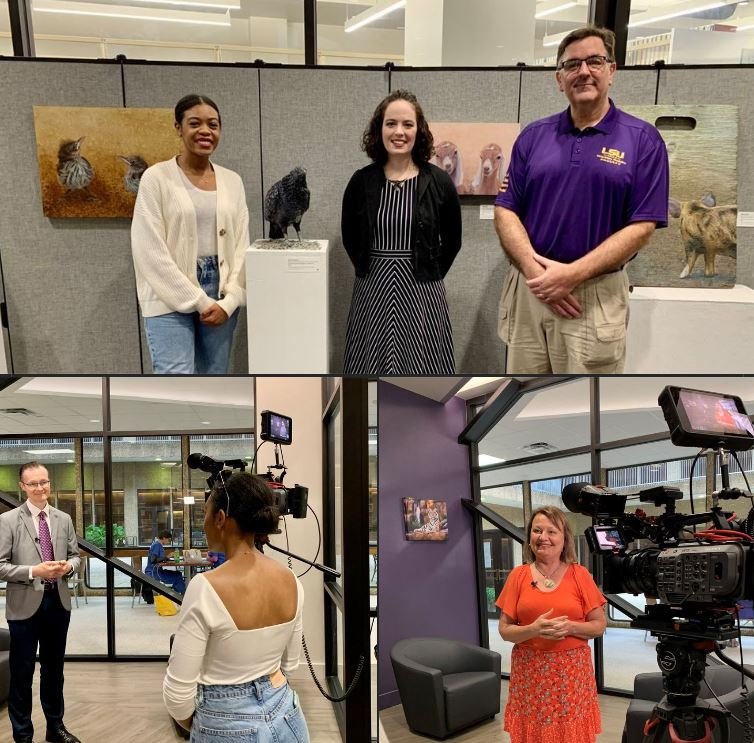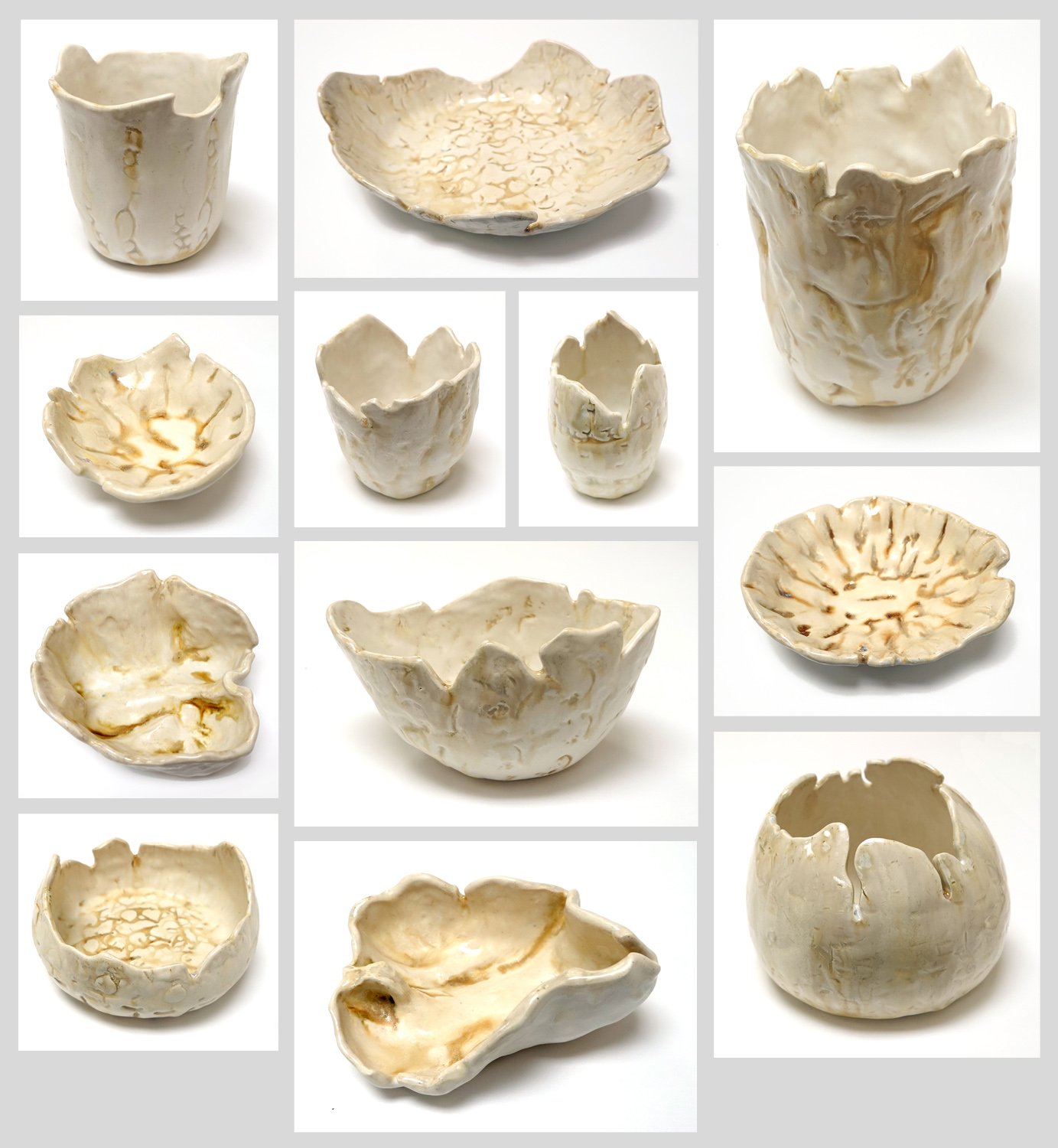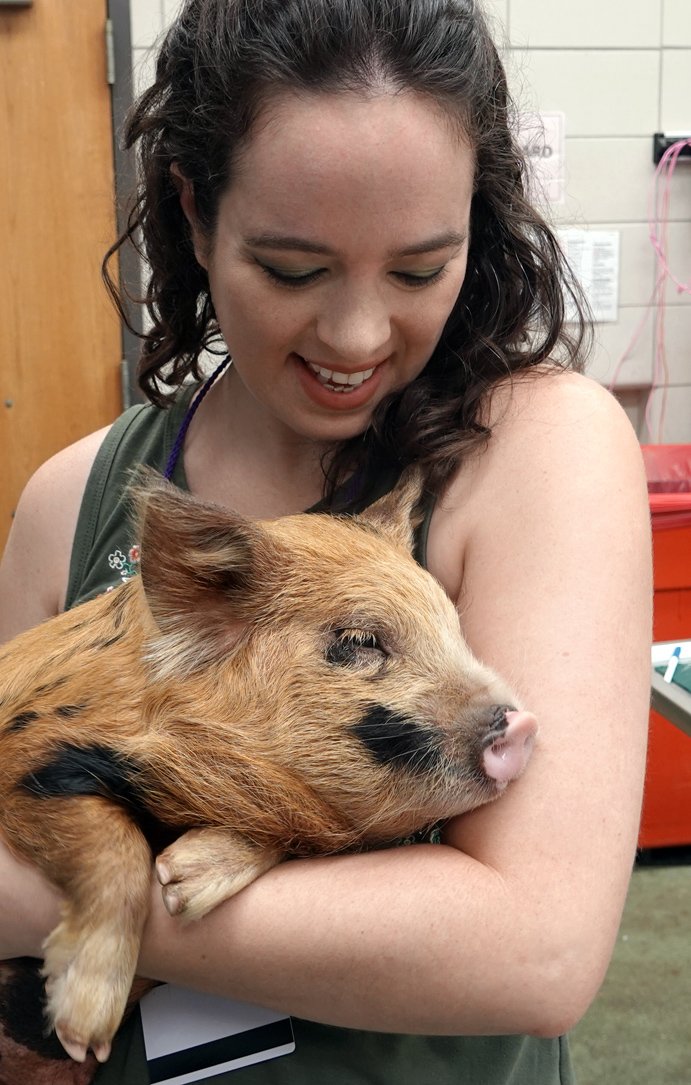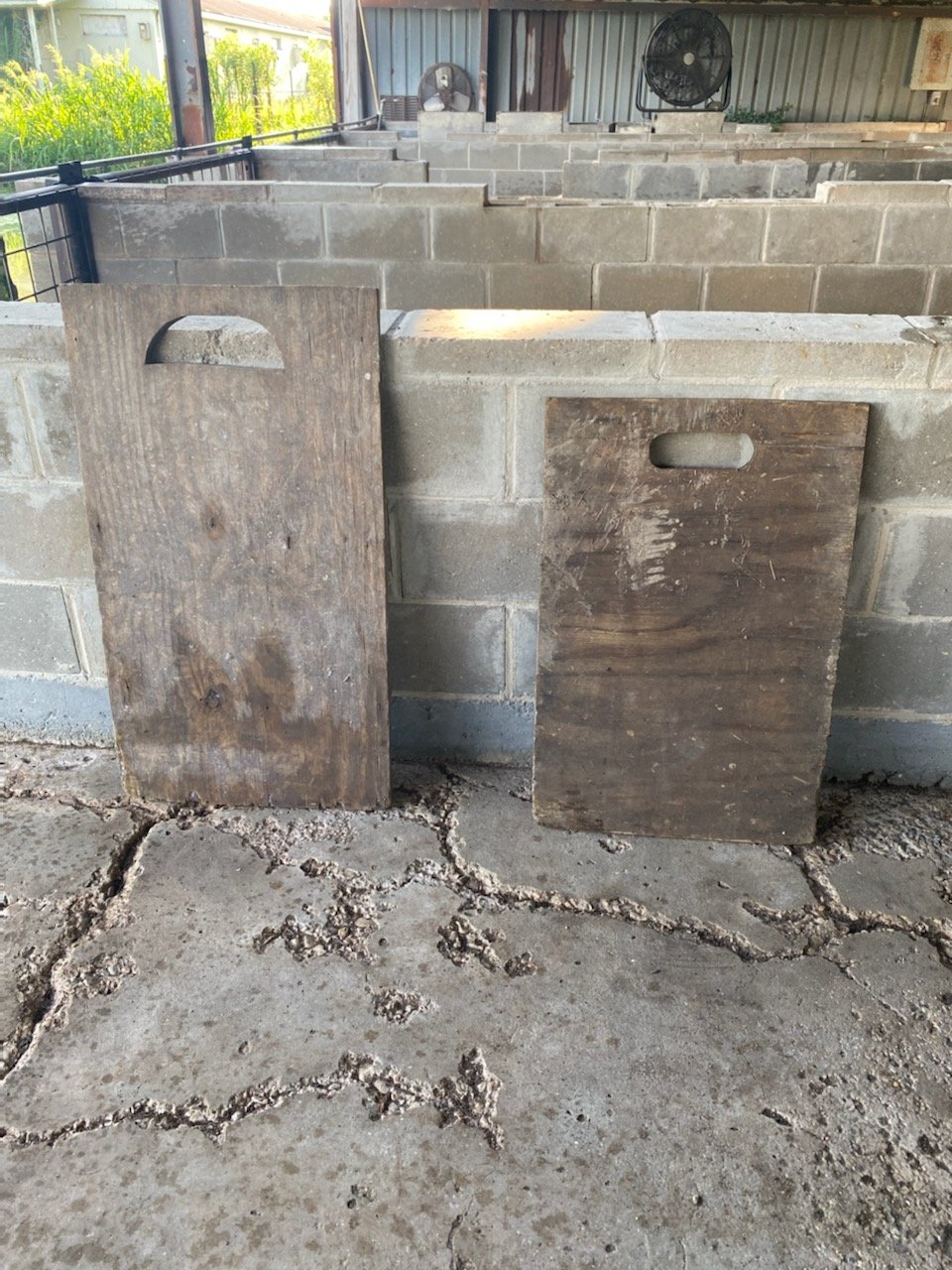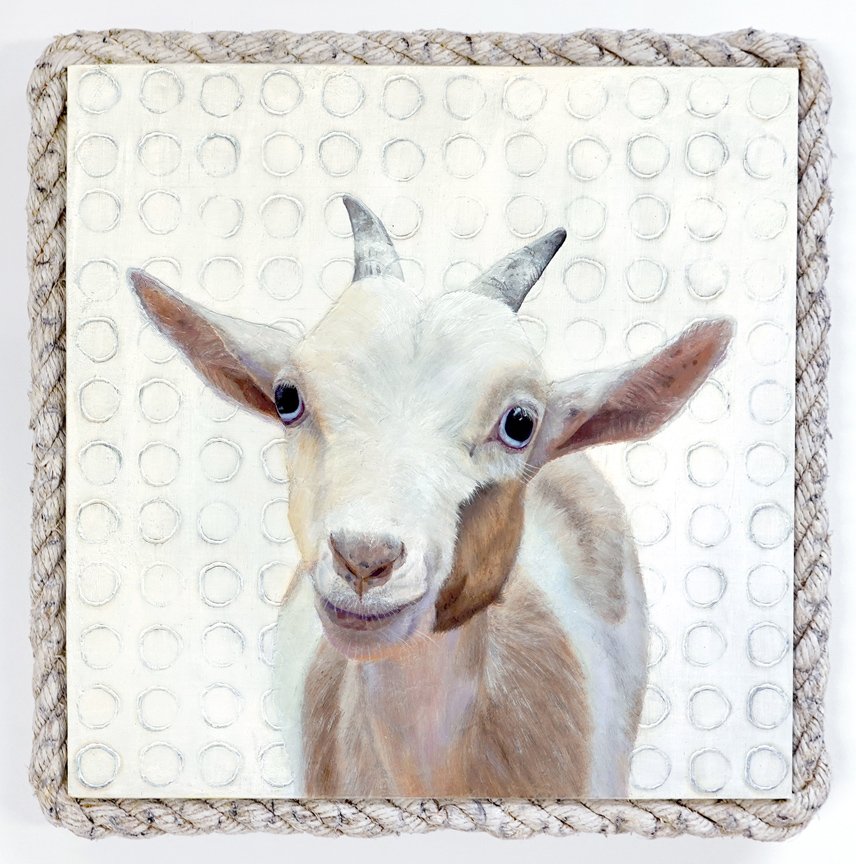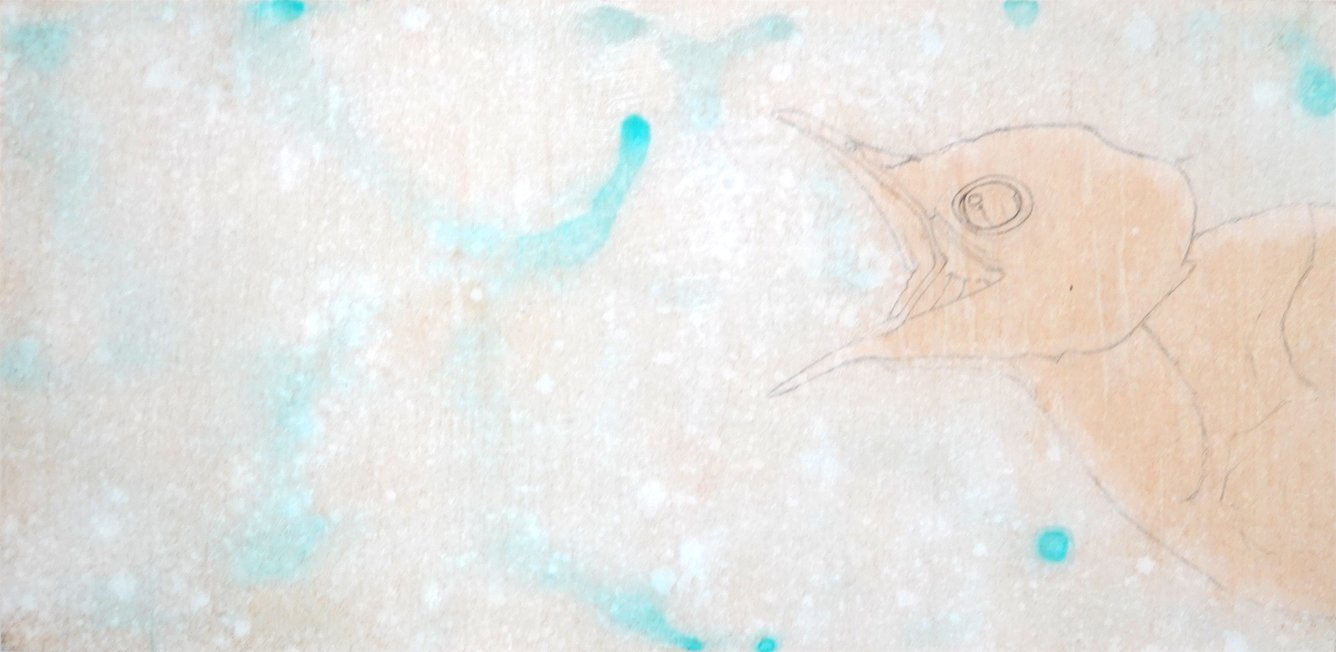The Morningside University News just got in on all the excitement - “Associate professor of art Shelby Prindaville uses skills towards historical process” was published on August 26th! The image on the right is a screenshot of the introduction, but check out the whole article in the link above or take a look at this PDF.
inaugural
Country Roads Magazine Feature!
Country Roads Magazine just published a fabulous article on my LSU Vet Med artist residency in both their digital and September print edition! On the left, you can see a screenshot of the beginning of the write-up to whet your appetite.
You can read the digital piece here, see a full PDF, or pick up a physical copy if you’re in the Louisiana/Mississippi distribution zone!
Sioux City Journal Feature!
I’ve been getting some nice Louisiana press for my summer LSU Vet Med artist residency, and now there’s great local coverage as well - with more in the works! Here’s the Sioux City Journal digital article “Morningside professor participates in first-ever artist residency at LSU vet school” by reporter Dolly Butz, and here’s a PDF of the print version!
Louisiana PBS Televised Feature!
Louisiana Public Broadcasting Service’s The State We’re In did a televised feature on my artist residency and exhibition at the LSU School of Veterinary Medicine - you can watch it here!
From their own website: “Louisiana: The State We’re In, Louisiana's only statewide news magazine, is in its 45th season on the air. The program airs Fridays at 7PM and Sundays at 4:30PM on the six-station LPB network that includes stations in Alexandria, Baton Rouge, Lafayette, Lake Charles, Monroe, and Shreveport. It also streams at lpb.org/livetv and airs on LPB’s sister station WLAE-TV32 in New Orleans on Fridays at 7PM and on WYES-TV, the PBS station for New Orleans and the Gulf Coast, at 7:30PM.
This award-winning show combines in-depth coverage about the important issues in the state along with expert analysis. […] It is one of the longest-running television programs in the nation.”
My LSU Vet Med Exhibition and Opening Reception!
Here are photos from my solo exhibition and opening reception at the LSU School of Veterinary Medicine, co-sponsored by the LSU School of Art! The reception was amazing; over 80 people attended and they were all very engaged throughout the evening. We began with a welcome speech delivered by LSU School of Veterinary Medicine Dean Oliver Garden, followed by speeches from LSU College of Art + Design Dean Alkis Tsolakis and LSU School of Art Director Rod Parker, and then my artist lecture!
By the end of the evening, 6 of the 8 paintings/relief/sculpture were sold (only Hosts and Singularity remain available), and 3 of the 13 ceramics were purchased in addition to countless prints and greeting cards. Through the course of the rest of the exhibition, 3 more ceramics sold along with additional prints and greeting cards. I was a little surprised at how popular the mosquito reproductions were as they sold out quite quickly, but I’ve since learned there’s a well-known joke that mosquitoes are the state bird of Louisiana!
In the slideshow, you’ll see that in addition to the artwork walls and reproduction sales table, I also had a display table of some of the veterinary materials - medicines, chemicals, stains, tools, bones - I used in each of the pieces of artwork!
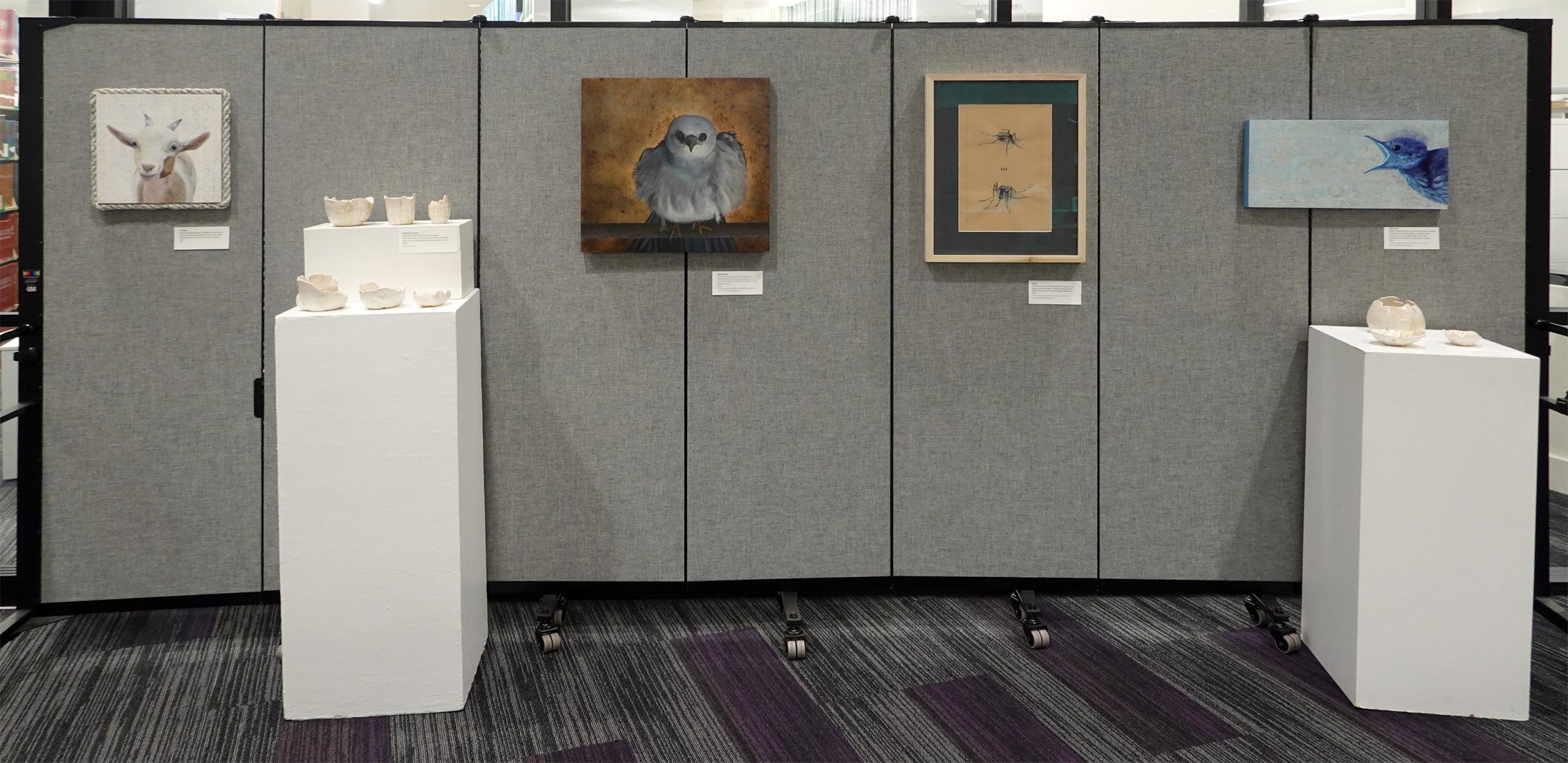
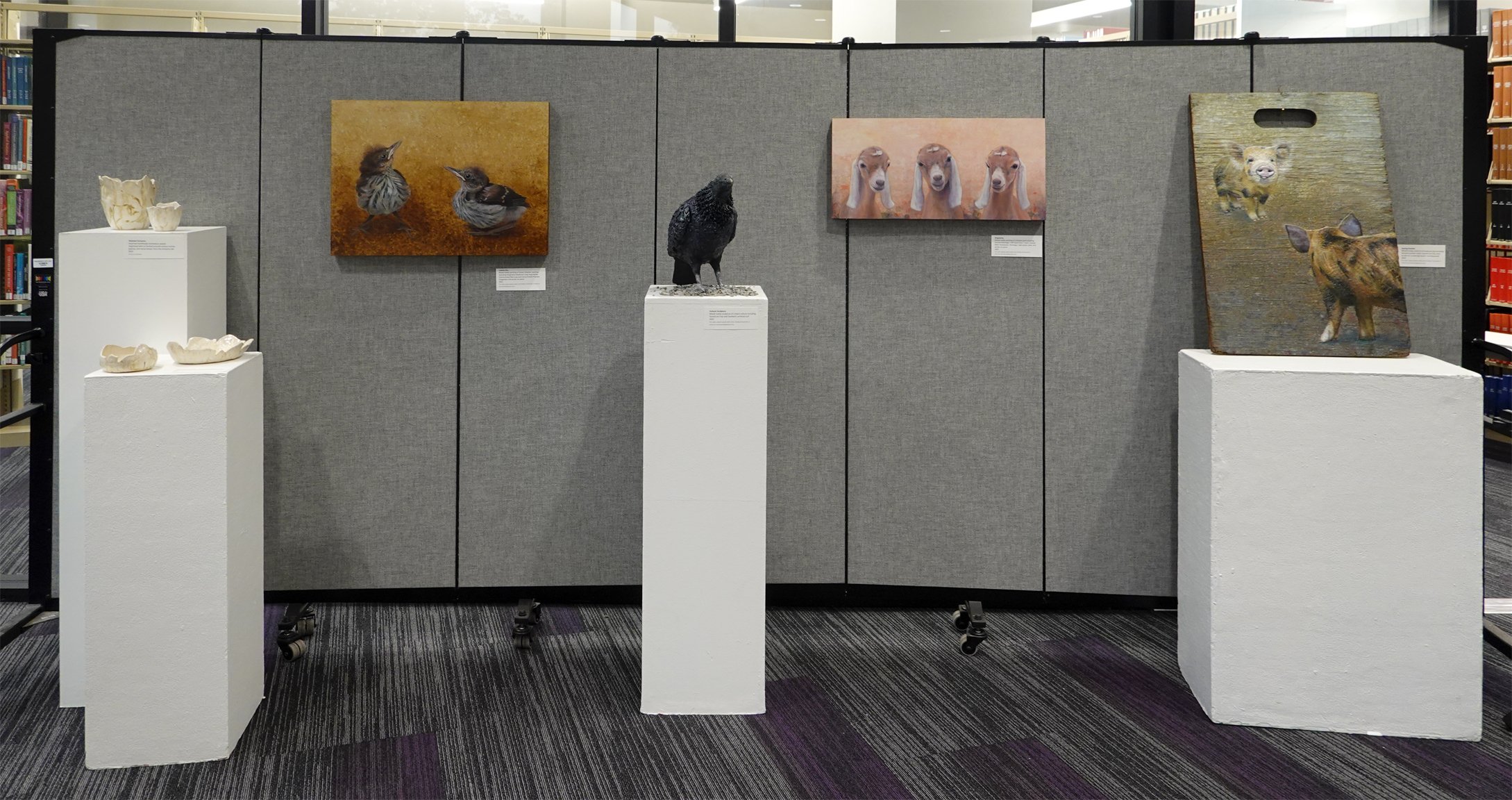
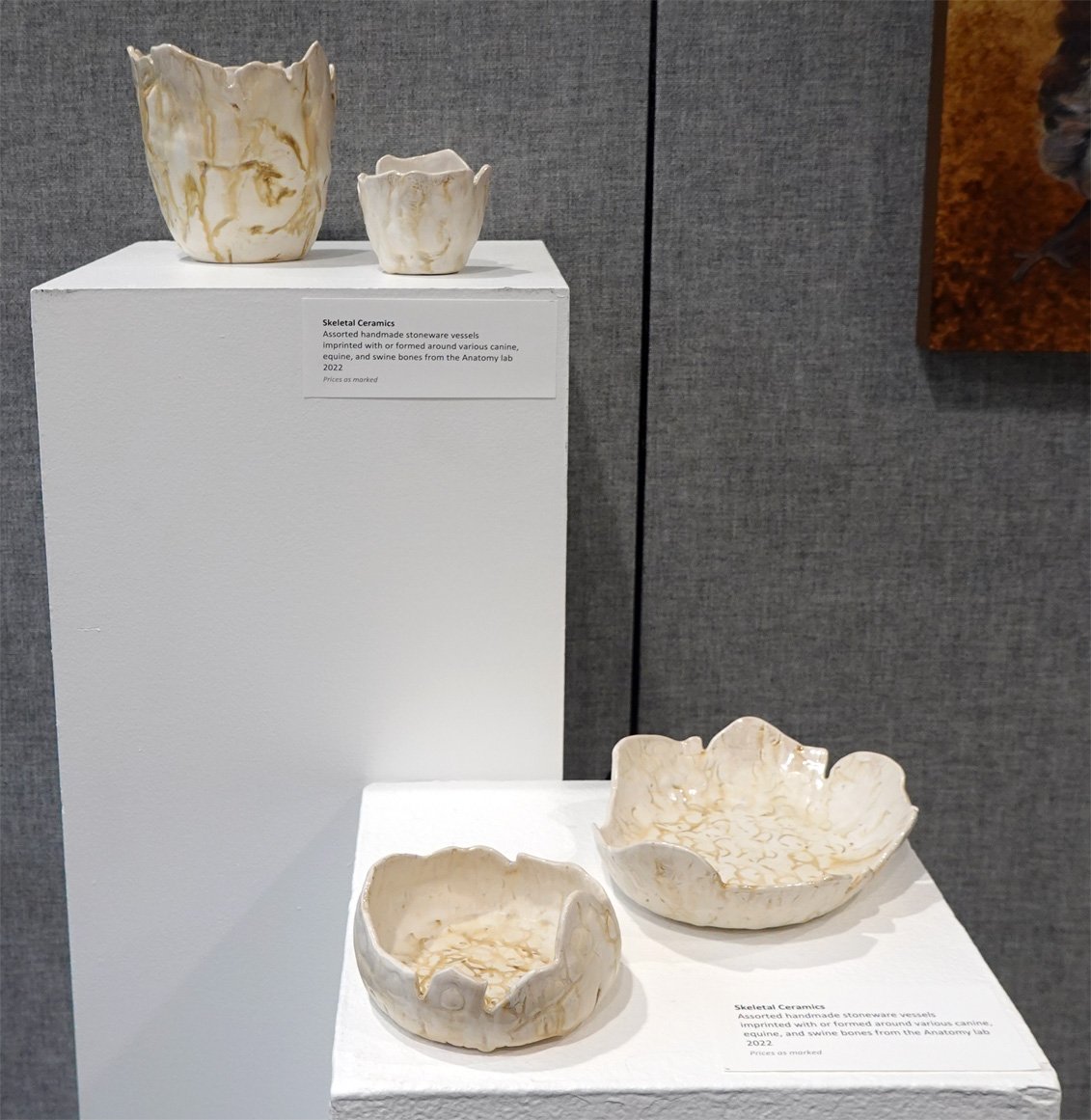
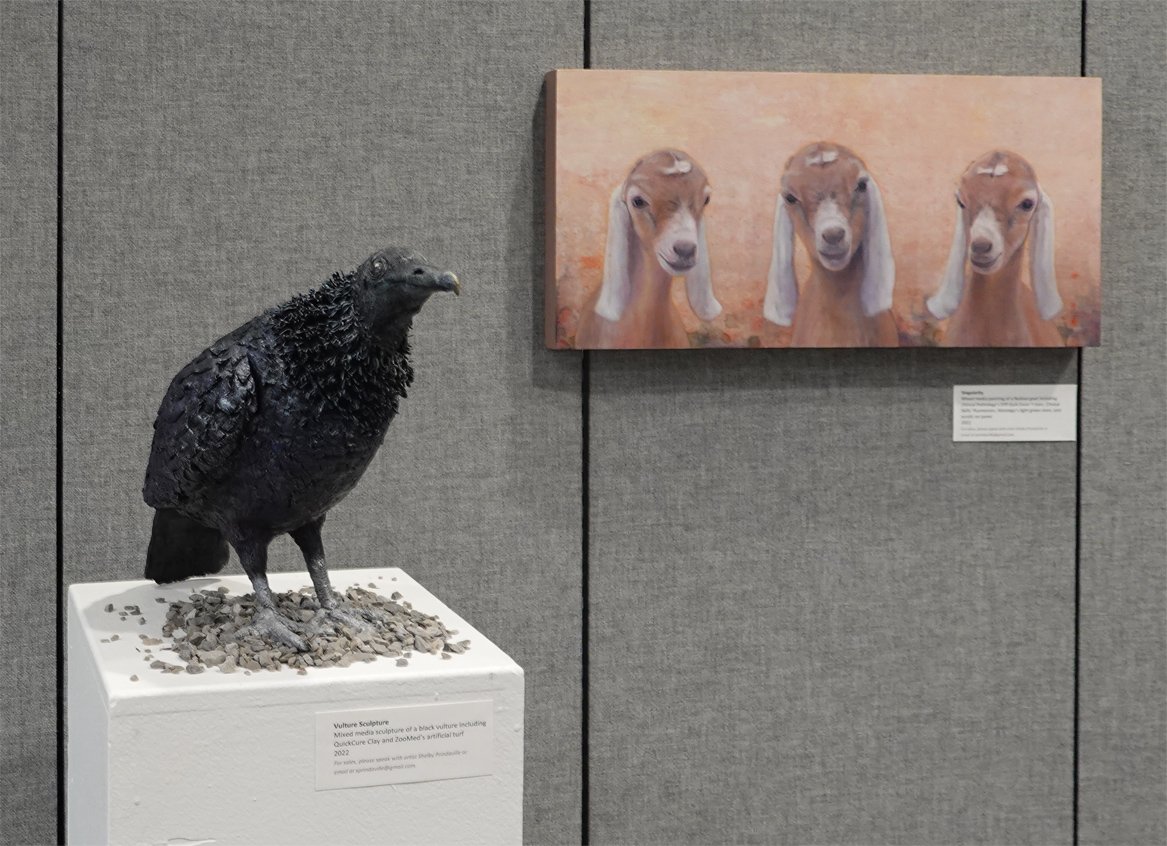

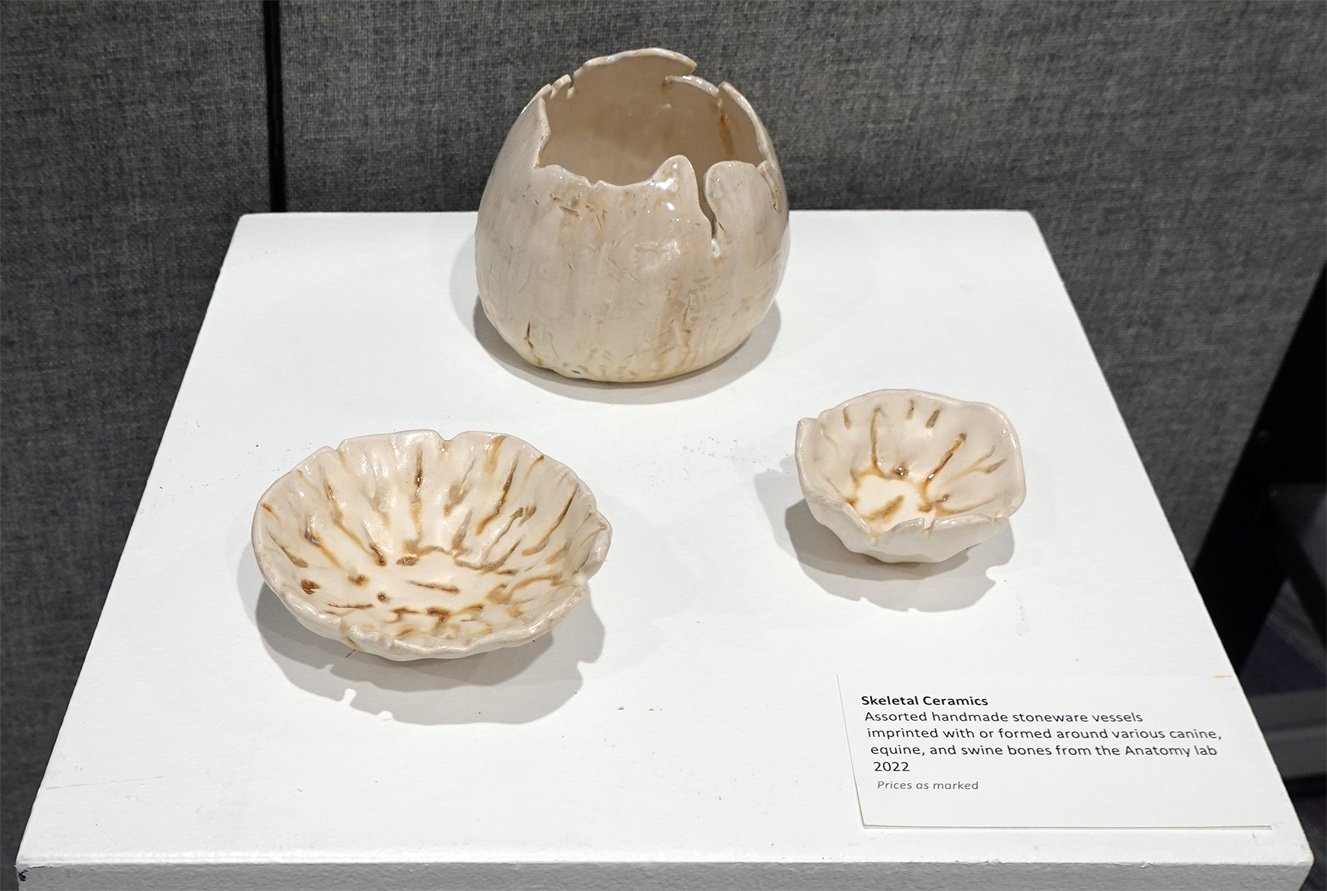
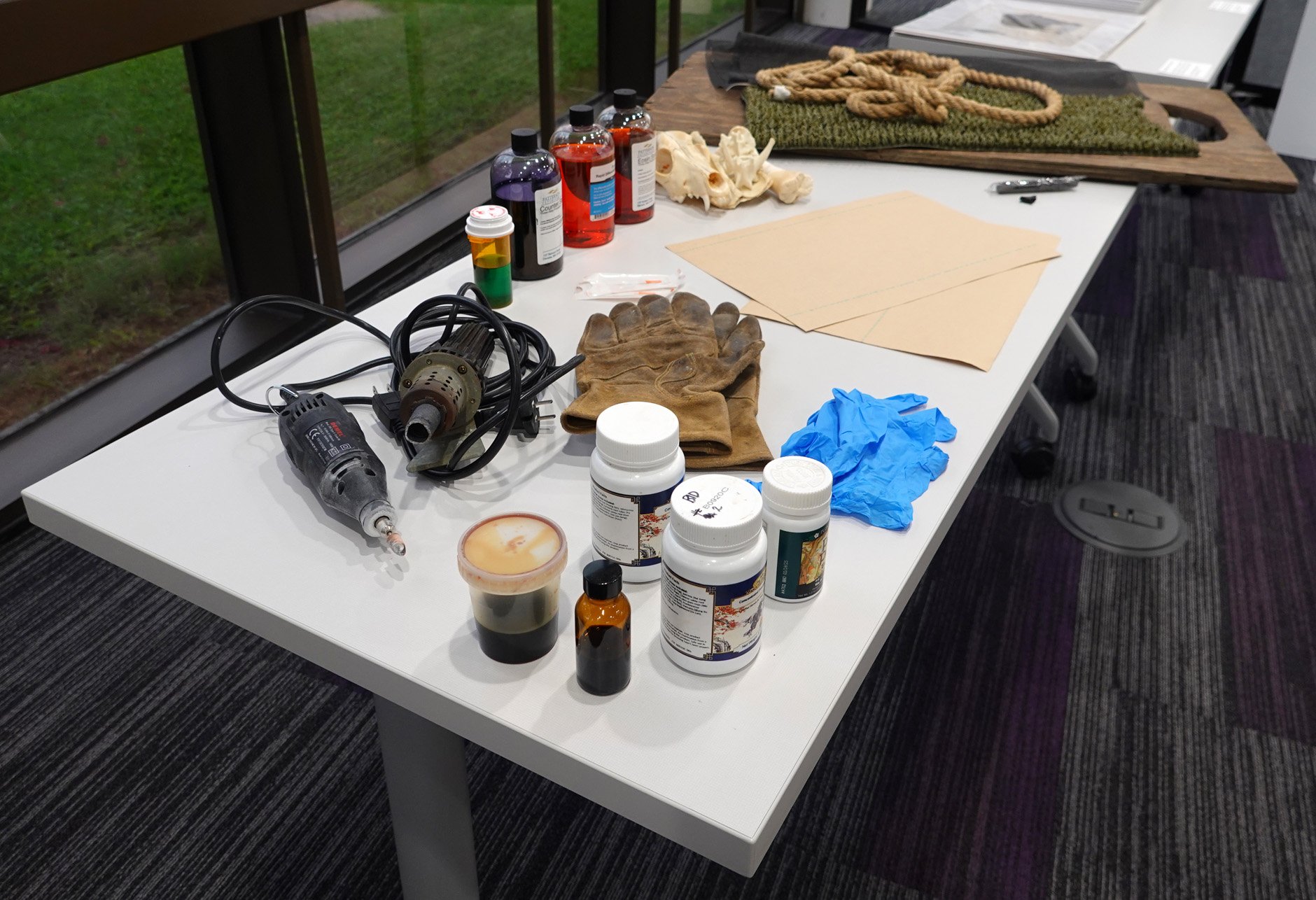
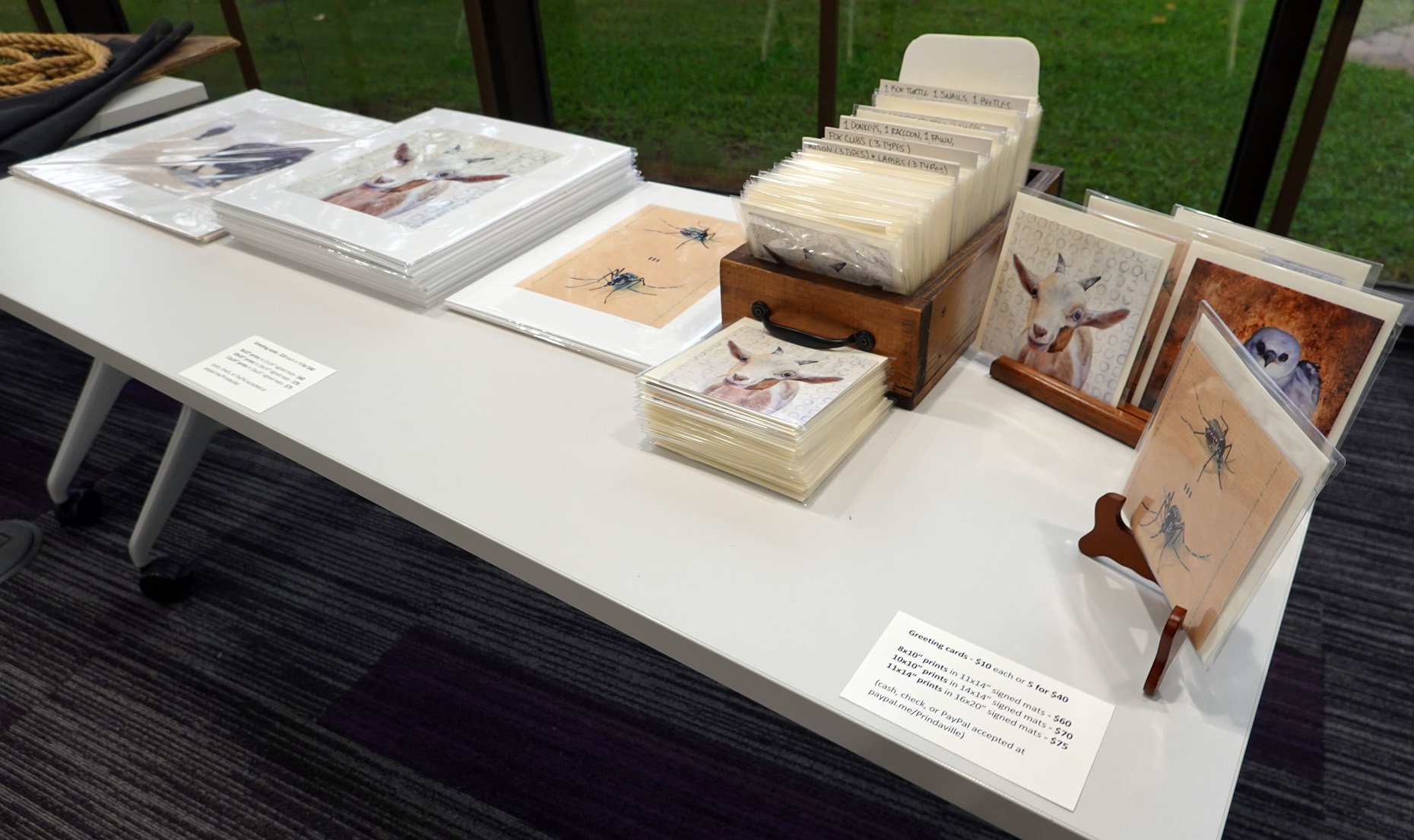
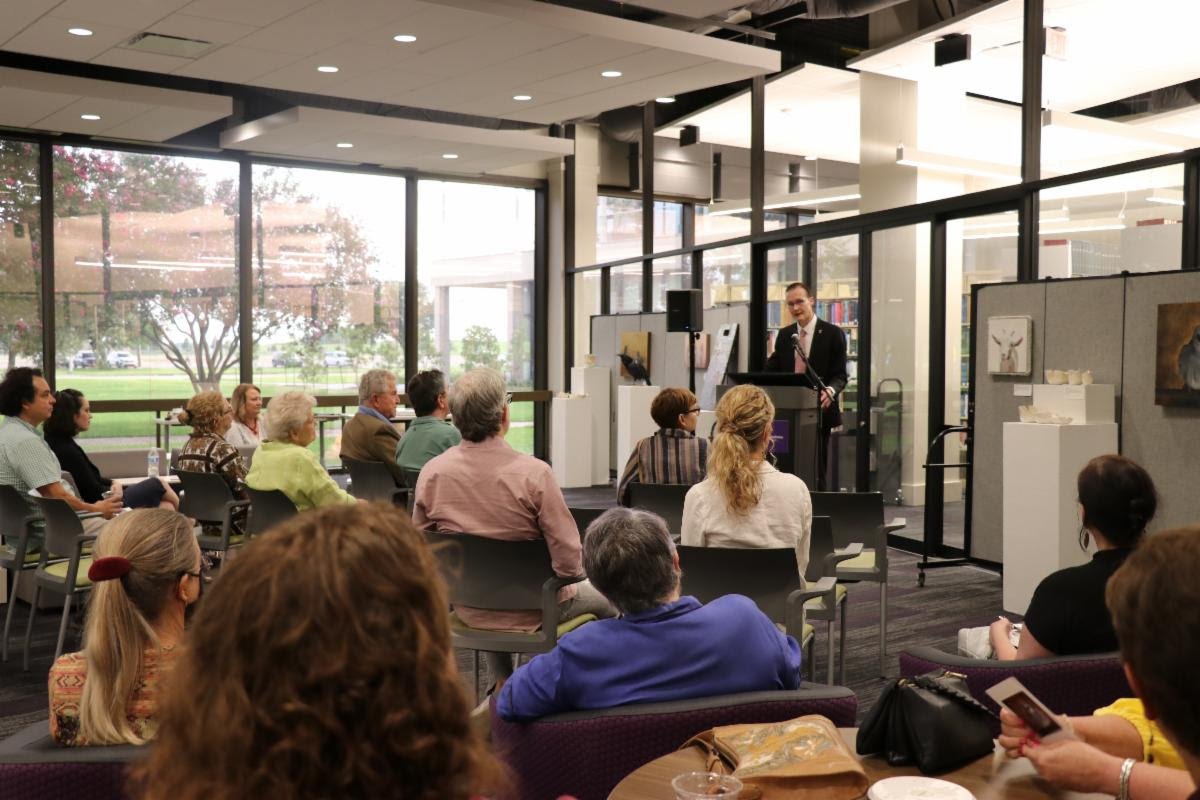

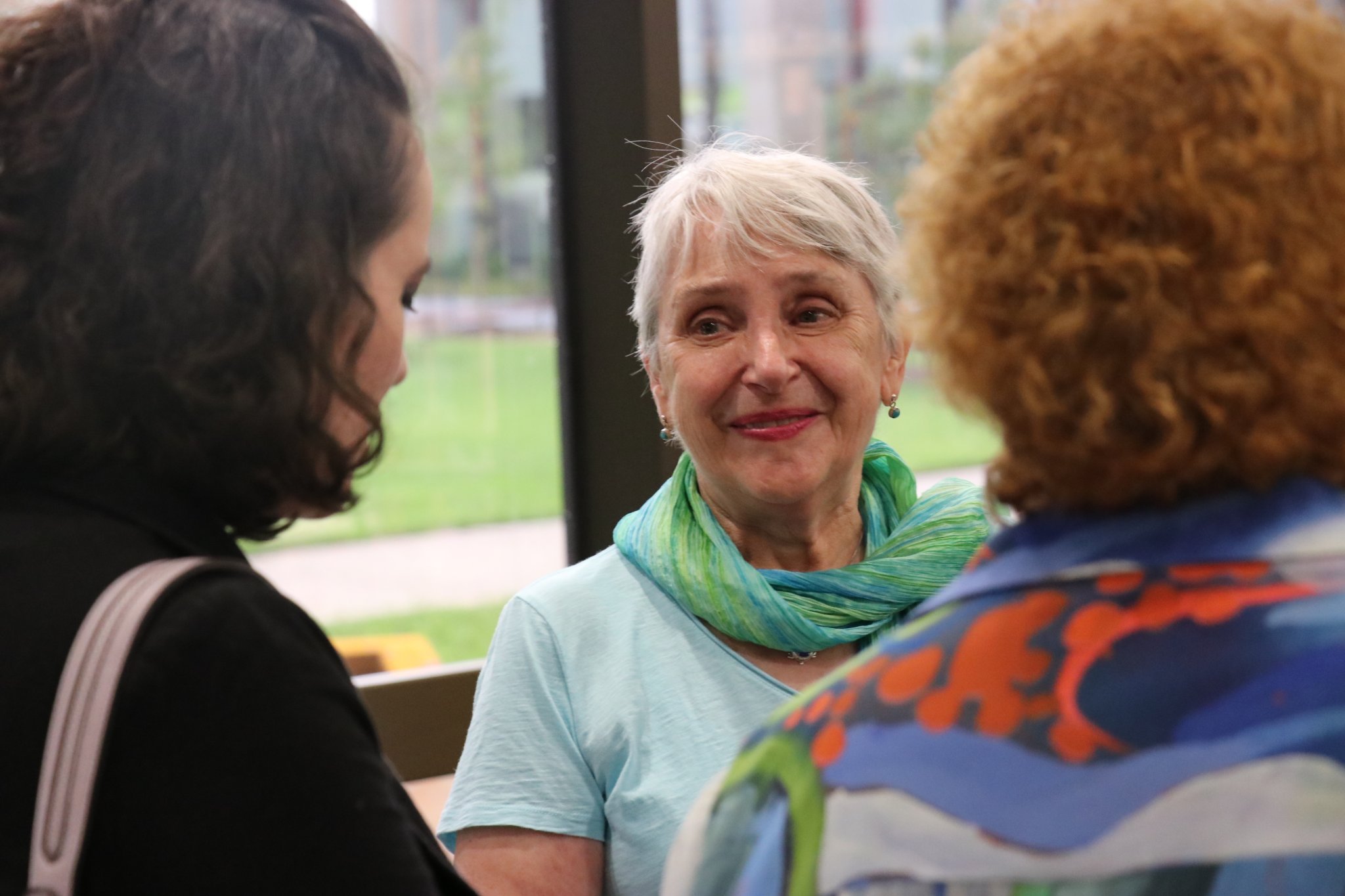
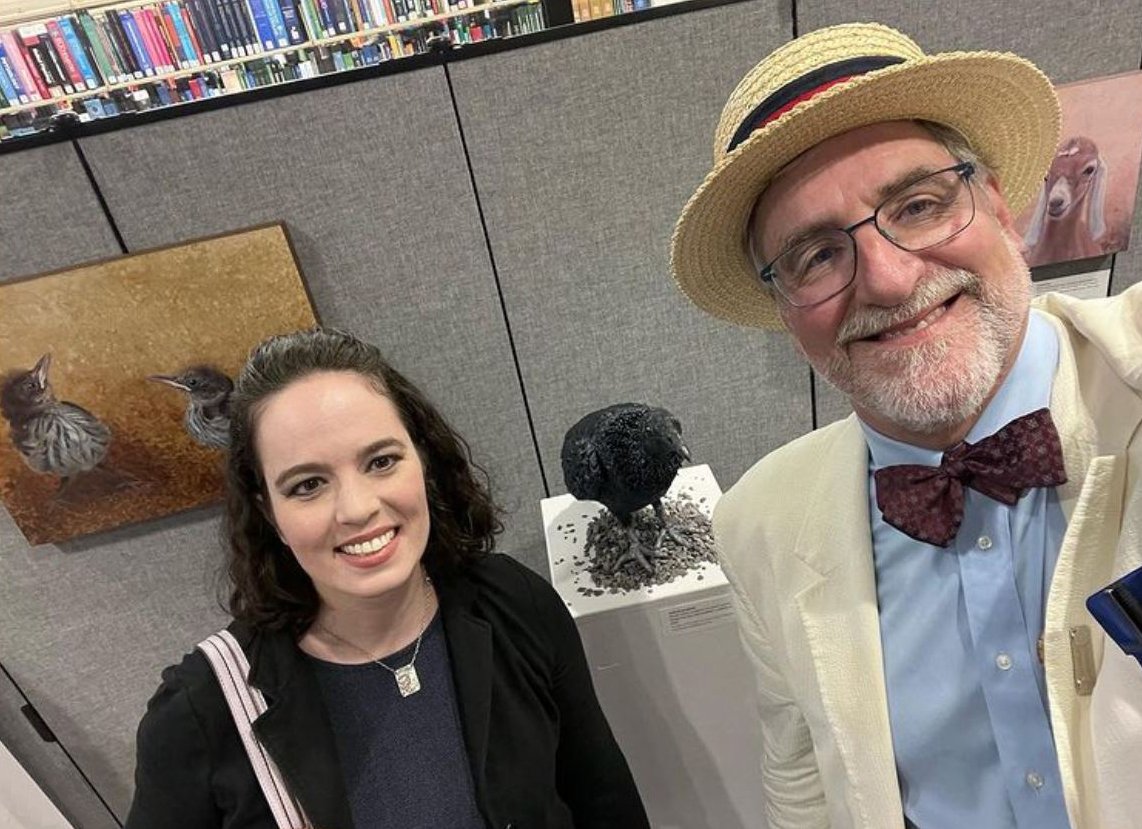
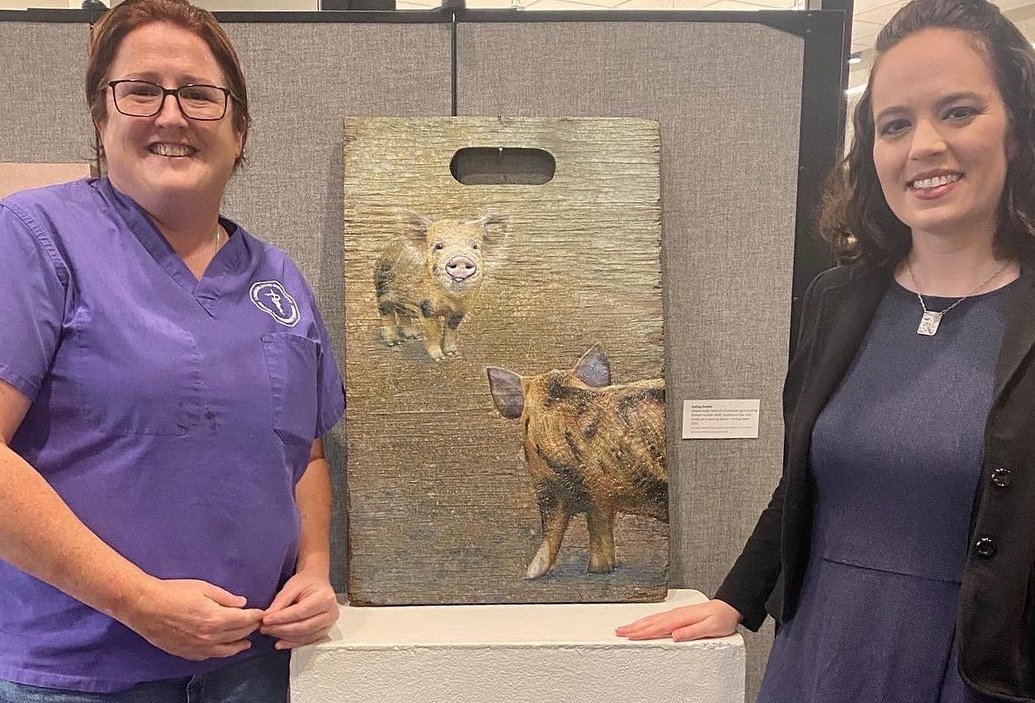
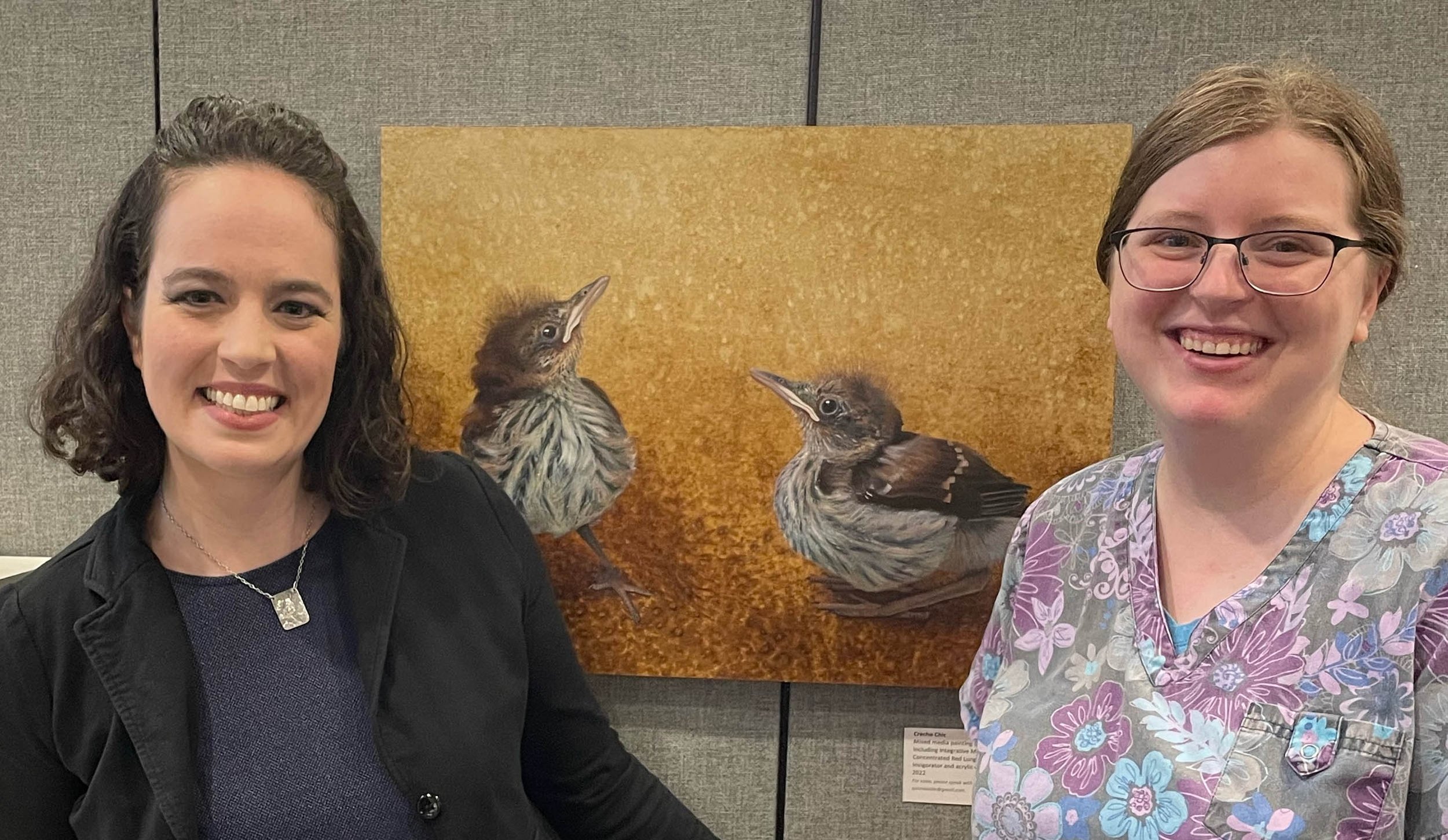
LSU Vet Med Artist Residency Artwork 20 Process
Here are a couple of photos of the in-progress Vulture Sculpture! In the first image, you can see how I built an internal armature out of pink styrofoam insulation, wire, and disposable chopsticks. Armatures are really helpful for a few reasons: A) they provide structure and support to bolster strength and keep the clay from sagging, B) they weigh a lot less than clay which makes the piece-in-progress lighter so it puts less stress on weight-bearing areas while wet/uncured C) if you leave the armature inside - like you can do with QuickCure Clay - the finished piece is lighter than if it were solid clay which is typically desirable, and finally D) the armature materials usually cost less than using an equivalent amount of clay.
Then in the second image, it’s midway along; I’m still sculpting the QCC (note the head and wings are unfinished) but it’s taking real shape and I’ve already incorporated the artificial turf, though I have yet to “mold” it with the heat gun. Finally, there’s the finished piece in a similar orientation for comparison!
LSU Vet Med Artist Residency Artwork 20
This is the final piece of artwork I completed on-site at LSU Vet Med during my two-month summer 2022 residency! I think finishing 20 exhibitable pieces including mixed media paintings, a relief, ceramics, and a sculpture in 7 weeks is a remarkable feat, so I am very happy with my productivity.
I worked right up until the day of the exhibition opening on this piece, but I managed to get it “finished” in time - I put that in quotes as I still needed to briefly borrow it back from the exhibition midway through to put a protective varnish on top!
I had wanted to do a sculpture this whole time because A) I’ve always liked putting on exhibitions that have multiple disciplines and media on display to more deeply engage a broad viewership, B) I wanted to really highlight QuickCure Clay, as I’d helped create it with Dr. John Pojman at LSU a decade ago and it felt right to use it in at least a couple of pieces this summer, and C) I had been given a couple pieces of artificial turf from the wildlife hospital that I wanted to incorporate into artwork in some way, and relatively early on I had a lightbulb moment wherein I thought the astroturf had vulture neck-feather vibes! It worked very well, in that a lot of people couldn’t figure out where the artificial turf was used and at least one viewer told me she thought I thought the gravel I used as an installation aid was astroturf. Another viewer asked me if this was a taxidermied piece, which made me feel really good about the likeness!
I titled this piece Vulture Sculpture mostly because I didn’t have time to think about titling it when I had to make the show labels (I didn’t even think it was likely to get finished for it!), but I also do like the rhyme and the clear identification of the species of the bird. I sold this sculpture that same evening to the fabulous Dr. Mark Mitchell from Wildlife and ZooMed and his partner Dr. Lorrie Hale Mitchell from Integrative Medicine! They very kindly were willing to let me take it on exhibit first (as I’m doing with the rest of the sold paintings), but I made some delicate choices with this piece - the claws, the beak tip - that meant I thought it best to let them just take it after my LSU Vet Med solo show came down instead of potentially injuring the piece in shipping.
This is Vulture Sculpture, a mixed media sculpture of a black vulture including QuickCure Clay and ZooMed’s artificial turf, 13.5" x 7.5" x 20.5", 2022.
LSU Vet Med Artist Residency Artwork 8-19
This is Skeletal Ceramics, assorted handmade stoneware vessels imprinted with or formed around various canine, equine, and swine bones from the anatomy lab, 2022.
I made this body of ceramics start-to-finish on site at the LSU School of Veterinary Medicine and with purchased supplies and firing assistance from Southern Pottery Equipment. The canine, equine, and swine bones used include skulls, jawbones, various vertebrae, scapula, femurs, and sacra. The glazes used were an Amaco Shino Cacao Matte Cone 5-6 Glaze (SH-32), a Spectrum Satin White Hi-Fire Cone 5 Glaze (1121), and a Spectrum Satin Mottle Hi-Fire Cone 5 Glaze (1122). I applied the Cacao Matte to all the textured/impressed areas and then sponged off the outer surfaces, then put on a generous two coats of the Satin White, and then painted a little of the Satin Mottle on kind of haphazardly and then more carefully at the lips. I fired to Cone 6. I was really happy with how this combination performed, as they do look like bone themselves! Seven of these pieces sold during the exhibition to three different buyers.
The anatomy lab allowed me to take the bones I’ve been using back with me so that I can continue to develop this collection, so stay tuned for more.
LSU Vet Med Artist Residency Artwork 7 Process
Here are some in-progress photos of Seeing Double!
LSU Vet Med Artist Residency Artwork 7
My seventh artwork almost didn’t get made on site - I knew what I wanted to do, but tried in vain to get my hands on a necessary component until Dr. Clare Scully came to the rescue!
Let me back up and explain it from the beginning. A very cute Kunekune pig named Tigger came in for observation and diagnosis and he left the next day feeling much better (and after I gave him a quick cuddle). With his owners’ permission, I decided I’d like to feature him in a painting or two! As I always do when I see a new species here at LSU Vet Med, I started asking about what veterinary materials they use specifically with that species - in this case, pigs. After hearing about a handful of items, the ones that seemed the most useful for my purposes were the pig sorting panels or “pig boards” and Dremel rotary tools (used to sand down hooves). I had brought a rotary tool with me as a sculpting aid already, so that was easy - but the pig sorting panel was a harder acquisition. This is because all the ones they had on hand were made out of plastic, and were pretty clearly intended to be easy to clean in a way that would make it harder to work archivally on top of and they were also obnoxiously colored. Wooden ones are regularly used, too, but there weren’t any in the large animal hospital as typically the wooden ones are just created on demand in a farm woodshop to save money and time.
I started asking all the large animal veterinarians, residents, and students if they knew of a source, put word out via my communications liaison Sandy Sarr, and posted a Craigslist ad… but a week had passed and my show exhibition was drawing closer so I thought I’d need to wait until I could ask my agricultural colleagues back in Iowa. And then Clare came into the room, we chatted, she said she’d see what she could do, and a couple of days later, she had done it! She had found two wooden pig boards for me that were the dimensions I had been looking for from another LSU site and said they were sufficiently used as to be destined for the scrap heap, so this was a much better use for them.
I happily adopted them both and gave them a light sanding and heavy cleaning. For the first composition I had in mind, the slightly smaller and more “standard” board worked better, so that’s what I went with! I would like to photograph it again when I get back home and have access to a large white background, but this image will do for now.
This is Seeing Double, a mixed media relief including Dremel counter relief, QuickCure Clay, PVP Prep Solution (betadine), and acrylic on a used pig board / sorting panel, 29.75x19.25x1.25”, 2022.
LSU Vet Med Artist Residency Artwork 6 Process
Here are process photos from Crèche Chic!
LSU Vet Med Artist Residency Artwork 6
As I may have shared before, I have met a bunch of amazing animals while here and there are a handful with whom I’ve really connected. This little fellow tops the list - you may recognize this brown thrasher from Wild Card, but here he is in his natural color palette and two different poses! I was fortunate enough to get to see pretty much his entire journey at the vet school in ZooMed’s wildlife hospital - from coming in as an abandoned nestling whose two siblings didn’t make it to his fledging and becoming a young adult, to his release! I will share his release photos in a different post.
The whole background is non-traditional veterinary media - namely, herbal treatments from Integrative Medicine! They created a really cool surface but were water-soluble and organic so I sealed over them several times with acrylic medium before painting the baby birds.
This is Crèche Chic, a mixed media painting including Integrative Medicine’s Jing Tang Herbal Concentrated Red Lung and Concentrated Prostate Invigorator and acrylic on panel, 18x24x1.5”, 2022.
LSU Vet Med Artist Residency Journal 6
The next week began with my making some more progress in the studio and also taking some more reference images for future artwork. However, what felt like allergies flaring up on Monday and Tuesday began to seem more suspicious by Tuesday evening, and Wednesday morning I took an at-home COVID test which reflected a positive result. I have been around a large number of unmasked people both at the vet school and at the various art receptions I’ve been attending, so I wasn’t terribly surprised given how infectious this latest wave has been.
When I called in with the news, LSU policy dictated that I stay out of the provided studio until five days of symptoms had passed. This would normally be a bit problematic from a productivity standpoint but otherwise unremarkable, except that the housing I’ve been provided is marginal and without an escape to go to (the studio and restaurants/cafes/shops), it is a unrealistic place to ask a professional guest to isolate for days.
Below are a couple of photos of the totality of housing space I’ve been provided. My host is a very kind and gracious artist himself, and he thinks that it’s ideally used as a very short term weekend or week-long stay and that LSU Vet Med was already pushing it to ask me to stay there for two months. He shared with me that as an isolating unit he views it as effectively a jail cell or a cubicle, and that he agrees it is unreasonable to ask anyone to isolate within it. (The last photo is how I sleep as the floor is more comfortable than the cot, but I store the pad on the cot when not sleeping as it is impossible to get to the bathroom or exit otherwise.) As you can imagine, I try not to spend much waking time in this space; I just use it as a place to sleep and shower.
I therefore had to scramble to find a hotel or Airbnb on extremely short notice. I managed to find a viable place - a studio apartment with a kitchen - and had to personally outlay approximately $400 (the cheapest functional arrangement I could find on same-day notice) to stay there for the rest of the isolation period.
The LSU School of Veterinary Medicine is unwilling to pay for or even share the cost of this expenditure, which is very disappointing. For anyone considering doing this artist residency, I’d just warn you that any housing or COVID issues you face while here are at your own cost and that their standard for acceptable housing is marginal. Staying in this space already cost me more than I’m used to in residency food expenses due to not having a kitchen (meaning I can only eat prepared foods or microwave or refrigerated meals), so requiring that I fully carry my isolation expenses on top strikes me as unprofessional on the part of the LSU Vet Med artist residency program. I am hesitant to recommend this residency without sharing this issue as it has been an unexpected and pretty significant negative. But rounding it out, in almost all other aspects I have had a good experience and other more minor problems have all seemed like teething pains that would naturally occur as the inaugural artist.
Once my isolation period ended and I was able to access the studio again, I moved back into the above pictured space and picked up where I’d left off on my studio practice.
The Advocate Feature Article!
The Advocate writer Robin Miller wrote up a lovely feature article for The Advocate on me, “LSU Vet School hosts first-ever resident artist: Combines clinical labs to create art” which was digitally published yesterday! (It hasn’t yet come out in the print version - I think Robin mentioned it will be in the Saturday edition.) Below is just a screenshot of the intro, but you should definitely follow the link above and read the whole piece!
LSU Vet Med Artist Residency Artwork 5 Process
And here are process pictures of Singularity from start to finish!
LSU Vet Med Artist Residency Artwork 5
This is actually the first piece I began here at the LSU School of Veterinary Medicine! I never know how to properly answer people as to how long a piece of artwork takes to finish, as my optimal process involves working on several different pieces simultaneously. If you count start to finish, I worked on it for a month and five days - however, there were a number of days in there that I didn’t touch this piece or only worked on it for a couple of hours…
The subject in this piece is a three-day-old baby Nubian goat; she was fully healthy but was brought in to accompany her brother who was failing to thrive and unfortunately didn’t make it.
Singularity, mixed media including Clinical Pathology’s Diff-Quik Eosin Y stain, Clinical Skills' fluorescein, Histology’s light green stain, and acrylic on basswood panel, 12x24x1.5”, 2022.
LSU Vet Med Artist Residency Artwork 4
This painting originated in the Epidemiology Department here at the LSU School of Veterinary Medicine! I met with a number of researchers in various departments, but Dr. Rebecca Christofferson’s lab offered me a very cool substrate that I wanted to use: mosquito ovipositioning paper! This paper, as its name suggests, is used by researchers to hatch mosquito eggs for research purposes. It’s an interestingly textured paper, and it has aqua lines on it in two configurations; on each 15x10” piece of paper, there are either two vertical lines 1” and 1.25” inside the border, or there is one line 4” inside (or 6”, depending on your perspective).
I asked what purpose the lines serve (they clearly serve some purpose, whether that be for researchers or as an artifact of the production process), and no one at LSU SVM has been able to tell me. I think that’s pretty funny, as it was my first question and the first question out of several of my artist friends’ mouths as well! Dr. Christofferson did just follow up with me to share the mosquito ovipositioning paper is apparently a repurposed seed germination paper, so I will try to follow that thread to see if I can figure out why the aqua lines exist!
As I shared in a previous journal, I took the photos of these mosquitoes myself. This composition includes two female Aedes aegypti mosquitoes, both after a bovine blood meal, and three mosquito eggs to scale with the mosquito depictions. I purposefully integrated cool tones and aqua shadows to tie in the aqua margin lines.
This is Hosts, acrylic on mosquito ovipositioning paper, 15x10”, 2022. It will be window-matted with an overlay of mosquito netting from the epidemiology lab on top of the matboard and framed. I’ll be assembling the frame with the help of my host Rob Carpenter, so I’m excited to see how it all comes together!
My Upcoming LSU Vet Med Artist in Residence Exhibition Details!
The show poster and details have been released for my LSU School of Veterinary Medicine Artist in Residence exhibition, co-sponsored by the LSU School of Art! Here’s the LSU College of Art & Design’s event page for it, and below is a copy of the image and text.
Artist-in-Residence, LSU School of Veterinary Medicine
July 25, 2022 5:30-7:30 p.m.
LSU Vet Med Library
LSU School of Veterinary Medicine presents the art of Shelby Prindaville, and invites you to a lecture and reception featuring our inaugural Artist-in Residence. The lecture, exhibition opening, and artist’s reception will be at LSU Vet Med Library and is co-sponsored by LSU School of Art.
LSU Vet Med Artist Residency Artwork 3
The adorable Nigerian Dwarf goat model is named Morticia, and she came into the large animal area in need of a Caesarean section. While she has been waiting for her labor to commence, she posed for me. The ways in which humans and animals coexist in domesticated relationships were inspiration for this piece.
Lineage is a mixed media painting incorporating goat halter rope, debudding tool marks, and acrylic on panel, 13.5x13.5x1.5", 2022.
LSU Vet Med Artist Residency Artwork 2 Process
As I mentioned in my first post about this painting, the coloration of the background comes from my novel usage of veterinary stains and medicine as art media, and I continued that color palette into the subject as well. However, there was a lot of trial and error in the creation of the background, and a cyan coloration that was produced ended up quickly going almost entirely fugitive (bleached out). I reinforced it with acrylic droplets as a final step, but as the painting continues to age, the background purple coloration is also beginning to fade. I may need to redo the whole background eventually, but right now I am adopting a wait-and-see approach!
This painting has already had a number of failed backgrounds, because two of the chemicals I tried to use for pigmentation clearly did not work from the start. The first I attempted was chlorhexidine, and the second was light green stain from Histology. “Wait a minute!” you might say to yourself. “Those chemicals are still listed in the mixed media!”
You’d be correct - I left them in because I kept sandwiching new chemicals between layers of acrylic medium, and I can’t be sure that some of those initial layers didn’t create the compositional effects that later resulted from the Diff-Quik methylene blue counter stain. That is the chemical that brought both the purple and strong cyan into to the background, but the cyan came from watering down or thinning out the stain and it began going fugitive quickly. The purple stuck around long enough that I thought it was permanent, but now it too is beginning to fade. I’ll continue to update you as to where this painting ends up, in terms of both aesthetics and process!



